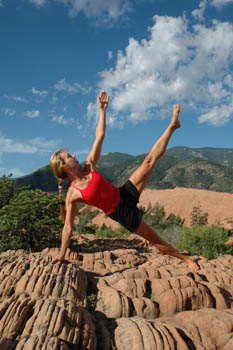Ask Lauri
Do you have a specific question for Lauri regarding Pilates and how it might benefit you? Email Lauri with your question and she will get back to you with an answer.
- How is Pilates different from other exercise programs?
Unlike other exercise programs, Pilates helps you do everything better. Whether it’s walking, dancing, skiing, playing golf — Pilates improves all movement. Pilates sculpts your body by working muscles evenly and uniformly. The end result is long lean muscles that are flexible and strong. In addition, Pilates engages your mind. You’ll learn movements that not only improve your fitness, but improve your balance, coordination and posture. You might even get taller. - How is Pilates different from Yoga?
Pilates is movement based. Unlike Yoga, Pilates doesn’t require you to maintain a still position. Instead, Pilates is based on a series of movements intended to improve core strength, flexibility, balance and sense of body awareness. In addition, Pilates requires deep abdominal engagement to support the spine and create core centered movement. Not only are the exercises challenging and fun, they’re functional. - Is Pilates appropriate for pregnant women?
Pilates is wonderful for pregnancy because it improves circulation, balance and strength. It helps women to stay toned, flexible and moving freely throughout their pregnancy. Women who do Pilates while pregnant have been known to regain a flatter tummy more quickly as well. Doing Pilates after pregnancy is very helpful to restoring core strength and balance to the body. - Why is Pilates considered a mind/body conditioning program?
Pilates requires precision, control and concentration in order to create movement that is fluid, easy and rewarding. Unlike some workouts, Pilates requires you to continuously think about what you are doing. As a result, you’ll find your Pilates workouts absorbing and even rejuvenating. It may be the one hour of your day when you’re able let go of everything except the present moment. - How soon after beginning Pilates will I see results?
Many people feel different after only one class, however real and lasting changes may take up to 10 sessions. - I have had many injuries and physical problems during my lifetime. Can Pilates help me?
Many people suffering from back pain or injury benefit greatly from Pilates. By developing a stronger core, improving alignment and body awareness, back pain can often be reduced if not eliminated. In addition, Pilates emphasis on sound biomechanics may help a person avoid re-injuring their back. Pilates is also great post re-hab exercise for sports injuries. Pilates restores strength and flexibility so you can get back to doing the activities you love. - What is the advantage of Pilates Apparatus classes versus Mat classes?
The mat work is wonderfully practical and complete. However, it does require a certain level of strength and flexibility. If you have an injury or are out of shape, mat work can be frustrating and inappropriate. The reformer is ideal for everyone. Whether you are an elite athlete or a couch potato, the reformer provides the exact amount of support and challenge you desire. In addition, the reformer enables you to stretch deeply in places that may be difficult to do effectively on the mat. - How many time a week should I practice Pilates?
Mr. Pilates recommended doing Pilates four days per week. I see most of my clients on average two times per week. Depending on your lifestyle and personal goals, I recommend devising a plan that is realistic for you. If you want to generate results quickly, you will benefit greatly from three days a week in the studio. Otherwise, I recommend consistently doing Pilates every week as a way of life to maintain better health and fitness. - Who can practice Pilates?
If you can breathe… you can do Pilates. Just lying on your back focusing on Pilates breathing, you will engage your abdominals. Pilates is wonderful for everyone. It is the ultimate form of cross training for athletes, and it is a preferred method of rehabilitation used by many physical therapists. In addition, no one is too old or too young to enjoy the benefits of Pilates. My clients range in age from 14 to 70. - How should I dress and should I bring anything?
It is best to wear clothing that is soft and allows you to move freely. Avoid wearing baggy clothes if possible. No shoes are required; we recommend wearing non-slip sticky socks. For your convenience we have these for sale at the studio. We provide shoe cubbies and a dressing area for changing.

If your spine is inflexible at 30, then you are old. If it is flexible at 60, you are young.


